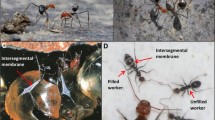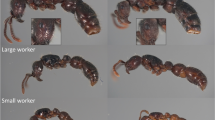Summary
Proximate control of colony dynamics was studied in the primitively eusocial halictine beeLasioglossum (Dialictus) zephyrum using allozyme markers. The results indicate that workers produce on average 15% of the male brood (range=0–50%) in small laboratory colonies made up of unrelated, single-generation, uninseminated females. This proportion is not influenced by colony size, but is influenced by the relative size of the queen. Large queens are more successful in dominating their workers than are small queens, the queen being defined as the female that is the mother of most of the brood produced in the colony. Older and larger females tend to become queens. Thus, while small differences in age (up to 4 days) influence which female becomes a queen, her ability to control her workers is primarily influenced by her relative size. The proportion of reproduction that is co-opted by the queen is negatively correlated with colony reproductivity (the number of males/day/female). Colony reproductivity is also negatively correlated with the standard deviation in size among females.
Similar content being viewed by others
References
Batra, S. W. T., 1964. Behavior of the social bee,Lasioglossum zephyrum, within the nest.Ins. Soc. 11:159–186.
Batra, S. W. T., 1966. The life cycle and behavior of the primitively social bee,Lasioglossum zephyrum (Halictidae).Univ. of Kans. Sci. Bull 47:359–423.
Batra, S. W. T., 1968. Behavior of some social and solitary halictine bees within their nests; a comparative study (Hymenoptera: Halictidae).J. Kans. Ent. Soc 41:120–133.
Beig, D., 1972. The production of males in queenright colonies ofTrigona (Scaptotrigona) postica.J. Apic. Res. 11:33–39.
Bell, W. J., 1973. Factors controlling initiation of vitellogenesis in a primitively social bee,Lasioglossum zephyrum.Ins. Soc. 20:253–260.
Bourke, A. F. G., 1988. Worker reproduction in the higher eusocial Hymenoptera.Quart. Rev. Biol. 63:291–311.
Breed, M. D., 1975. Life cycle and behavior of a primitively social bee,Lasioglossum rohweri (Hymenoptera: Halictidae).J. Kans. Ent. Soc. 48:64–80.
Breed, M. D., 1976. The evolution of social behavior in primitively social bees: a multivariate analysis.Evolution 30:234–240.
Breed, M. D., 1977. Interactions among individuals and queen replacement in a eusocial halictine bee. In:Proc. 8th Int. Cong. IUSSI, Netherland, Wageningen.
Breed, M. D. and G. J. Gamboa, 1977. Behavioral control of workers by queens in primitively eusocial bees.Science 195:694–696.
Brian, M. V., 1983.Social Insects — Ecology and Behavioral Biology. Chapman and Hall Ltd. New York.
Brooks, R. W. and D. W. Roubik, 1983. A halictine bee with distinct castes:Halictus hesperus (Hymenoptera: Halictidae) and its bionomics in central Panama.Sociobiology 7:263–282.
Brothers, D. J. and C. D. Michener, 1974. Interactions in colonies of primitively social bees. III. Ethometry of division of labor inLasioglossum zephyrum (Hymenoptera: Halictidae).J. Comp. Physiol 90:129–168.
Buckle, G. R., 1982a. Queen-worker behavior and nestmate interactions in young colonies ofLasioglossum zephyrum.Ins. Soc. 29:125–137.
Buckle, G. R., 1982b. Differentiation of queens and nestmate interactions in newly established colonies ofLasioglossum zephyrum.Sociobiology 7:8–20.
Buckle, G. R., 1984. A second look at queen-forager interactions in the primitively eusocial halictid,Lasioglossum zephyrum.J. Kans. Ent. Soc. 57:1–6.
Buckle, G. R., 1985. Increased queen-like behavior of workers in large colonies of the sweat beeLasioglossum zephyrum.Anim. Behav. 33:1275–1280.
Campos, M. J. de O., 1980.Aspectos da sociologia e fenologia de Pereirapis semiauratus.Dissertacao (Mestre) da Univ. Federal de Sao Carlos, S.P., Brazil, (10) + 188 pp.
Dickinson, J. L. and C. E. McCulloch, 1989. Maximum likelihood estimation to assign paternity within multiple sired broods: Use of the EM algorithm.Anim. Behav. 38:719–721.
Dobzhansky, T., 1968. Adaptedness and fitness. In:Population Biology and Evolution (R. C. Lewontin, Ed.), Syracuse, NY: Syracuse Univ. Press, pp. 109–121.
Duchateau, M. J., 1987. Reproductive strategies of colonies ofBombus terrestris. In:Chemistry and Biology of Social Insects (J. Eder, H. Rembold, Eds.), Verlag J. Peperny, München, pp. 557–558.
Duchateau, M. J., 1989.The regulation of colony development in the bumblebee, Bombus terrestris. Ph. D. Thesis. Rijgksuniversiteit te Utrecht.
Eickwort, G. C., 1985. The nesting biology of the sweat beeHalictus farinosus in California, with notes onH. ligatus.Pan-Pacif. Entomol. 61:122–137.
Eickwort, G. C., 1986. First steps into eusociality: the sweat beeDialictus lineatulus.Fla. Entomol. 69:742–754.
Eickwort, G. C. and K. R. Eickwort, 1971. Aspects of the biology of Costa Rican halictine bees. II.Dialictus umbripennis and adaptations of its caste structure to different climates.J. Kans. Ent. Soc. 44:343–373.
Garofalo, C. A., 1985. Social structure ofEuglossa cordata nests.Entomol. Gener. 11:77–83.
Greenberg, L., 1982. Year-round culturing and productivity of a sweat bee,Lasioglossum zephyrum (Hymenoptera: Halictidae).J. Kans. Ent. Soc 55:13–22.
Greenberg, L. and G. R. Buckle, 1981. Inhibiting of worker mating by queens in a sweat bee (Lasioglossum zephyrum).Ins. Soc. 28:347–352.
Goukon, D., S. F. Sakagami and Y. Maeta, 1986. Bionomic comparison of two subpopulations of a eusocial halictine beeLasioglossum duplex in northern Japan.Japn. J. Ecol. 55:587–600.
Hamilton, W. D., 1972. Altruism and related phenomena, mainly in social insects.Ann. Rev. Ecol. Syst. 3:192–232.
Hughes, C. R. and J. E. Strasmann, 1988. Age is more important than size in determining dominance among workers in the primitively eusocial waspPolistes instabilis.Behavior 107:1–14.
Kamm, D. R., 1974. Effects of temperature, day length, and number of adults on the sizes of cells and offspring in a primitively social bee.J. Kans. Ent. Soc. 47:8–18.
Knerer, G., 1980. Biologie and Sozialverhalten von Bienenarten der GattungHalictus Latreille.Zool Jahrb. (Syst.) 107:511–536.
Knerer, G., 1981. Biologie von vier kleinen Evylaeus-Arten im Mittelmeergebiet.Zool. Anz. 206:1–10.
Knerer, G., 1983. The biology and social behavior ofEvylaeus linearis (Schenck).Zool. Anz. 211:177–186.
Kukuk, P. F. and B. P. May, 1985. A re-examination of genetic variability inDialictus zephyrus (Hymenoptera, Halictidae),Evolution 39:226–228.
Kukuk, P. F. and B. P. May, 1988. Dominance hierarchy in the primitively eusocial beeLasioglossum (Dialictus) zephyrum: Is genealogical relationship important?Anim. Behav. 36:1848–1850.
Kumar, S., 1975. Relations among bee size, cell size, and caste inLasioglossum zephyrum.J. Kans. Ent. Soc. 48:374–380.
Litte, M., 1977. Aspects of the social biology of the beeHalictus ligatus in New York State.Ins. Soc. 24:9–36.
May, B., J. E. Wright and M. Stoneking, 1979. Joint segregation of biochemical loci in Salmonidae: results from experiments withSalvelinus and review of the literature on other species.J. Fish. Res. Bd. Can. 36:1114–1128.
Metcalf, R. A., 1980. Sex ratios, parent-offspring conflict, and local competition for mates in the social waspsPolistes metricus andPolistes variatus.Am. Nat. 116:642–654.
Michener, C. D., 1964. Reproductive efficiency in relation to colony size in Hymenoptera societies.Ins. Soc. 4:317–342.
Michener, C. D., 1974.The Social Behavior of the Bees. A Comparative Study. Cambridge: Belknap Press.
Michener, C. D., 1988.Reproduction and caste in social halictine bees. W. Engles (ed.)Social Insects: An Evolutionary Approach to Castes and Reproduction. Munich; Springer-Verlag, pp. 75–119.
Michener, C. D. and D. J. Brothers, 1971. A simplified observation nest for burrowing bees.J. Kans. Ent. Soc. 44:236–239.
Michener, C. D. and D. J. Brothers, 1974. Were workers of eusocial Hymenoptera initially altruistic or oppressed?Proc. Nat. Acad. Sci. (USA) 71:671–674.
Michener, C. D., D. J. Brothers and D. R. Kamm, 1971a. Interactions in colonies of primitively social bees II. Artificial colonies ofLasioglossum zephyrum.Proc. Nat. Acad. Sci (USA) 68:1241–1245.
Michener, C. D., D. J. Brothers and D. R. Kamm, 1971b. Interactions in colonies of primitively social bees II. Queen-worker relations inLasioglossum zephyrum.J. Kans. Ent. Soc. 44:276–279.
Owen, R. E. and R. C. Plowright, 1982. Worker-queen conflict and male parentage in bumble bees.Behav. Ecol. Sociobiol 11:91–99.
Packer, L., 1983. The nesting biology and social organization ofLasioglossum (Evylaeus) laticeps (Hymenoptera: Halictidae) in England.Ins. Soc. 30:367–375.
Packer, L., 1985. Two social halictine bees from southern Mexico with a note on two bee hunting philanthine wasps.Pan-Pacif. Entomol. 61:291–298.
Packer, L., 1986a. The social organization ofHalictus ligatus (Hymenoptera; Halictidae) in southern Ontario.Can. J. Zool. 64:2317–2324.
Packer, L., 1986b. Competition over oviposition in subtropical and temperate populations of the social sweat beeHalictus ligatus. In:Chemistry and Biology of Social Insects (J. Eder, H. Rembold, Eds.), Verlag J. Peperny, Munich, p. 391.
Packer, L., 1987. An unexpectedly high female bias to the sex ratio in a temperate population ofHalictus ligatus — a primitively social sweat bee. In:Chemistry and Biology of Social Insects (J. Eder, H. Rembold, Eds.), Verlag J. Peperny, Munich, p. 391.
Packer, L. and G. Knerer, 1985. Social evolution and its correlate in bees of the subgenusEvylaeus (Hymenoptera: Halictidae).Behav. Ecol. Sociobiol 17:143–149.
Packer, L. and G. Knerer, 1986. The biology of a subtropical population ofHalictus ligatus Say I. Phenology and social organization.Behav. Ecol. Sociobiol. 18:363–375.
Page, R. E., Jr. and E. H. Erickson, 1988. Reproduction of worker honeybees.Behav. Ecol. Sociobiol. 23:117–126.
Queller, D. C. and K. F. Goodnight, 1989. Estimation of genetic relatedness using allozyme data.Evolution 43:258–275.
Röseler, P. F. and L. Röseler, 1977. Dominance in humbleness. In:Proc. 8th Int. Congr. IUSSI, pp. 232–234.
Sakagami, S. F., 1980. Bionomics of the halictine bees in northern Japan I.Halictus (Halictus) tsingtouensis (Hymenoptera: Halictidae), with notes on the number of origins of eusociality.Kontyû 48:526–536.
Sakagami, S. F., 1982. Stingless bees. In:Social Insects Vol. 3, (H. R. Hermann, Ed.), pp. 361–423.
Sakagami, S. F. and M. Munakatta, 1972. Distribution and bionomics of a transpalearactic, eusocial, halictine bee,Lasioglossum (Evylaeus) calceatum in northern Japan with reference to its solitary life cycle at high altitudes.J. Fac. Sci Hokkaido Univ. Ser. 6, Zool. 18:411–439.
Sakagami, S. F., Y. Hirashima, Y. Maeta and T. Matsumura, 1982. Bionomic notes on the social halictine beeLasioglossum affine.Esakia 19:161–176.
Seeley, T. D., 1985.Honeybee Ecology. Princeton, New Jersey: Princeton University Press.
Smith, B. H., 1987. Effects of genealogical relationship and colony age on dominance hierarchy in the primitively eusocial beeLasioglossum zephyrum.Anim. Behav. 35:211–217.
Smith, B. H., 1988. Genealogical relationship and social dominance in bees: A reply to Kukuk & May.Anim. Behav. 34:1850–1851.
Sokal, R. R. and F. J. Rohlf, 1969.Biometry. San Francisco: W.H. Freeman.
Trivers, R. L. and H. Hare, 1976. Haplodiploidy and the evolution of the social insects.Science 191:249–263.
Velthuis, H., 1987. The evolution of sociality: Ultimate and proximate factors leading to primitive social behavior in carpenter bees. In:From Individual to Collective Behavior in Social Insects, (J. M. Pasteels, J. L. Denenbourg, Eds.),Experientia Suppl. 54:405–430.
Visscher, P. K., 1989. A quantitative study of worker reproduction in honey bee colonies.Behav. Ecol. Sociobiol. 25:247–254.
West-Eberhard, M. J., 1967. Foundress associations in polistine wasps. Dominance hierarchies and the evolution of social behavior.Science 157:1584–1585.
West-Eberhard, M. J., 1977. The establishment of reproductive dominance in social wasp colonies. In:Proc. 8th Int. Congr. IUSSI, pp. 223–227.
Author information
Authors and Affiliations
Rights and permissions
About this article
Cite this article
Kukuk, P.F., May, B. Colony dynamics in a primitively eusocial halictine beeLasioglossum (Dialictus) zephyrum (Hymenoptera: Halictidae). Ins. Soc 38, 171–188 (1991). https://doi.org/10.1007/BF01240967
Received:
Accepted:
Issue Date:
DOI: https://doi.org/10.1007/BF01240967




